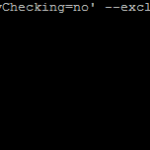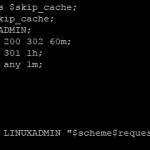
Compiling Apache 2.4 from source is easy and allows for more customization later on. It also allows for control over where it is installed
Install some required depedencies:
yum install -y wget pcre-devel openssl openssl-devel expat-devel
First get the latest version, at the time of writing this it is 2.4.25. The link to download the latest version is here
wget -O /usr/src/httpd-2.4.25.tar.gz http://mirror.nexcess.net/apache//httpd/httpd-2.4.25.tar.gz
Change directories to /usr/src
cd /usr/src
Uncompress the tar
tar xfvz httpd-2.4.25.tar.gz
Go to the directory:
cd httpd-2.4.25
The build we are creating requires apr and apr-util so to the src lib directory and download the following (APR download page):
cd ./srclib wget http://mirror.stjschools.org/public/apache//apr/apr-1.5.2.tar.gz wget http://mirrors.gigenet.com/apache//apr/apr-util-1.5.4.tar.gz
Uncompress them and rename them:
tar xfvz apr-1.5.2.tar.gz; mv apr-1.5.2 apr tar xfvz apr-util-1.5.4.tar.gz; mv apr-util-1.5.4 apr-util
Configure Apache:
Go back to the main source directory:
cd ../
To view the configure options type the following
./configure --help
This is a sample config:
./configure \ --enable-layout=RedHat \ --prefix=/usr \ --enable-expires \ --enable-headers \ --enable-rewrite \ --enable-cache \ --enable-mem-cache \ --enable-speling \ --enable-usertrack \ --enable-module=so \ --enable-unique_id \ --enable-logio \ --enable-ssl=shared \ --with-ssl=/usr \ --enable-proxy=shared \ --with-included-apr
Make:
make
Install:
make install
Start Services:
CentOS 7
Create a systemd start file by creating /etc/systemd/system/httpd.service and add
[Unit] Description=The Apache HTTP Server [Service] Type=forking PIDFile=/var/apache/httpd.pid ExecStart=/usr/sbin/apachectl start ExecReload=/usr/sbin/apachectl graceful ExecStop=/usr/sbin/apachectl stop KillSignal=SIGCONT PrivateTmp=true [Install] WantedBy=multi-user.target
Configure it to start on boot:
systemctl enable httpd
Start it
systemctl start httpd
CentOS 6
chkconfig --add httpd chkconfig httpd on service httpd start
That’s it for compiling Apache from source. If you visit the http://ip-address of the server you should see a default page for apache.
You can also verify its running by typing the following:
# ps aux|grep httpd root 1101 0.0 0.0 105376 836 pts/0 S+ 21:03 0:00 grep httpd nobody 15834 0.0 0.4 270908 8288 ? S 03:46 0:00 /usr/sbin/httpd -DHAVE_PROXY_FTP -DHAVE_AUTH_TOKEN -DHAVE_PROXY_HTTP -DHAVE_RPAF -DHAVE_PHP5 -DHAVE_XSENDFILE -DHAVE_AUTH_MYSQL -DHAVE_PROXY -DHAVE_PROXY_AJP -DHAVE_PROXY_BALANCER -DHAVE_PROXY_SCGI -DHAVE_SSL -DHAVE_PROXY_CONNECT -DSSL -DSSL -DSSL nobody 15835 0.0 0.4 270764 8224 ? S 03:46 0:00 /usr/sbin/httpd -DHAVE_PROXY_FTP -DHAVE_AUTH_TOKEN -DHAVE_PROXY_HTTP -DHAVE_RPAF -DHAVE_PHP5 -DHAVE_XSENDFILE -DHAVE_AUTH_MYSQL -DHAVE_PROXY -DHAVE_PROXY_AJP -DHAVE_PROXY_BALANCER -DHAVE_PROXY_SCGI -DHAVE_SSL -DHAVE_PROXY_CONNECT -DSSL -DSSL -DSSL nobody 15836 0.0 0.4 270764 8224 ? S 03:46 0:00 /usr/sbin/httpd -DHAVE_PROXY_FTP -DHAVE_AUTH_TOKEN -DHAVE_PROXY_HTTP -DHAVE_RPAF -DHAVE_PHP5 -DHAVE_XSENDFILE -DHAVE_AUTH_MYSQL -DHAVE_PROXY -DHAVE_PROXY_AJP -DHAVE_PROXY_BALANCER -DHAVE_PROXY_SCGI -DHAVE_SSL -DHAVE_PROXY_CONNECT -DSSL -DSSL -DSSL nobody 15837 0.0 0.4 270764 8224 ? S 03:46 0:00 /usr/sbin/httpd -DHAVE_PROXY_FTP -DHAVE_AUTH_TOKEN -DHAVE_PROXY_HTTP -DHAVE_RPAF -DHAVE_PHP5 -DHAVE_XSENDFILE -DHAVE_AUTH_MYSQL -DHAVE_PROXY -DHAVE_PROXY_AJP -DHAVE_PROXY_BALANCER -DHAVE_PROXY_SCGI -DHAVE_SSL -DHAVE_PROXY_CONNECT -DSSL -DSSL -DSSL nobody 15838 0.0 2.1 321656 40916 ? S 03:46 0:00 /usr/sbin/httpd -DHAVE_PROXY_FTP -DHAVE_AUTH_TOKEN -DHAVE_PROXY_HTTP -DHAVE_RPAF -DHAVE_PHP5 -DHAVE_XSENDFILE -DHAVE_AUTH_MYSQL -DHAVE_PROXY -DHAVE_PROXY_AJP -DHAVE_PROXY_BALANCER -DHAVE_PROXY_SCGI -DHAVE_SSL -DHAVE_PROXY_CONNECT -DSSL -DSSL -DSSL nobody 15839 0.0 1.6 292740 32276 ? S 03:46 0:00 /usr/sbin/httpd -DHAVE_PROXY_FTP -DHAVE_AUTH_TOKEN -DHAVE_PROXY_HTTP -DHAVE_RPAF -DHAVE_PHP5 -DHAVE_XSENDFILE -DHAVE_AUTH_MYSQL -DHAVE_PROXY -DHAVE_PROXY_AJP -DHAVE_PROXY_BALANCER -DHAVE_PROXY_SCGI -DHAVE_SSL -DHAVE_PROXY_CONNECT -DSSL -DSSL -DSSL nobody 15840 0.0 1.6 291948 31052 ? S 03:46 0:00 /usr/sbin/httpd -DHAVE_PROXY_FTP -DHAVE_AUTH_TOKEN -DHAVE_PROXY_HTTP -DHAVE_RPAF -DHAVE_PHP5 -DHAVE_XSENDFILE -DHAVE_AUTH_MYSQL -DHAVE_PROXY -DHAVE_PROXY_AJP -DHAVE_PROXY_BALANCER -DHAVE_PROXY_SCGI -DHAVE_SSL -DHAVE_PROXY_CONNECT -DSSL -DSSL -DSSL nobody 15841 0.0 1.6 291948 31048 ? S 03:46 0:00 /usr/sbin/httpd -DHAVE_PROXY_FTP -DHAVE_AUTH_TOKEN -DHAVE_PROXY_HTTP -DHAVE_RPAF -DHAVE_PHP5 -DHAVE_XSENDFILE -DHAVE_AUTH_MYSQL -DHAVE_PROXY -DHAVE_PROXY_AJP -DHAVE_PROXY_BALANCER -DHAVE_PROXY_SCGI -DHAVE_SSL -DHAVE_PROXY_CONNECT -DSSL -DSSL -DSSL
httpd -M will show the compiled modules:
# httpd -M Loaded Modules: core_module (static) authn_file_module (static) authn_default_module (static) authz_host_module (static) authz_groupfile_module (static) authz_user_module (static) authz_default_module (static) auth_basic_module (static) cache_module (static) mem_cache_module (static) include_module (static) filter_module (static) log_config_module (static) logio_module (static) env_module (static) expires_module (static) headers_module (static) usertrack_module (static) unique_id_module (static) setenvif_module (static) version_module (static) mpm_prefork_module (static) http_module (static) mime_module (static) status_module (static) autoindex_module (static) asis_module (static) cgi_module (static) negotiation_module (static) dir_module (static) actions_module (static) speling_module (static) userdir_module (static) alias_module (static) rewrite_module (static) so_module (static) ssl_module (shared)
Configuration Changes
The configuration is located in /etc/httpd/conf/httpd.conf typically.
How to change default ports
Apache listens on ports by the Listen directive to change it from port 80 (default)
Listen 8080
How to enable ssl in httpd.conf
Edit /etc/httpd/conf/httpd.conf and ensure the following line is uncommented:
LoadModule ssl_module modules/mod_ssl.so
And add the following line
Listen 443
You will need to restart the service if you make any changes to the configuration files.



